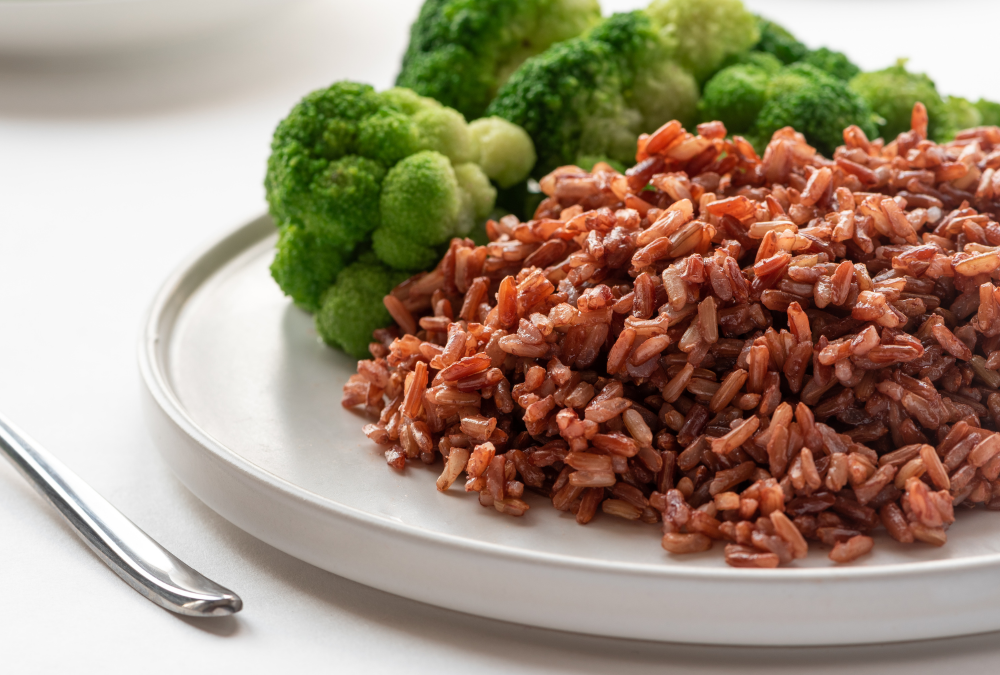Red, Purple or Black Rice: The Ways We Cook Make a Difference

Red Singapore Rice
August 25, 2022
Peanut Milk with Red Rice
September 14, 2022Happy rice, happy life! Rice has been the most important food crop over several millennia. Since people are becoming more health conscious and discerning about food choices, rice is now more than just a staple food but also is a powerhouse of various nutrients and bioactive compounds essential for optimal health.1 Recently, pigmented rice, aka “coloured rice”, has been gaining attention attributed to its notable nutritional values.2 Similar to brown rice, pigmented rice is an unpolished specialty rice, where the nutrient-packed bran and germ layers remain intact. As the name implies, one distinguishing factor for pigmented rice is the presence of pigments in the pericarp and aleurone layer of the rice kernel.3 These pigments not only give the rice their unique shades of colour (i.e., red, purple or black) but also contributes to its free-radical-scavenging capacities.4 Anthocyanins are predominant phenolic compounds that act as natural colorants for pigmented rice. They are potent phytochemicals which exhibit pleiotropic health effects associated with their antioxidant, anti-inflammatory, anticancer as well as antidiabetic properties.4
Therefore, it is conceivable that the health potential of pigmented rice depend largely on the availability of anthocyanins content. Despite being a powerful phytochemical, anthocyanins are labile to domestic cooking process due to its high water solubility and thermal sensitivity.5 For instance, significant reduction of anthocyanin content during cooking process was reported in pigmented rice varieties. This may attenuate the antioxidant potential of pigmented rice, undermining their role as a “superfood” to mitigate non-communicable diseases. Thus, it is imperative for the consumers to know the detrimental effects of cooking on the anthocyanin content of pigmented rice and to select the optimal cooking procedure to preserve their phytochemical content and antioxidant properties.
The deterioration of anthocyanin begins as soon as the rice undergoes precooking procedure such as washing and soaking. In light of the hydrophilic properties of anthocyanins, washing is expected to rinse off the anthocyanins of pigmented rice. Notwithstanding the foregoing, previous study showed that washing pigmented rice up to 3 times (i.e., soaking in cold water for 5 minutes each time with water discarded) did not cause significant loss of anthocyanin.10 This could be due to the fact that the seed coat (i.e., testa) serves as an impermeable barrier that prevent the anthocyanins in the aleurone layer from leaching out during washing.12 Prolonged soaking (³ 4 hours), on the other hands, resulted in a considerable loss of anthocyanins (18%-51%) from pigmented rice.11 This is because prolonged soaking will lead to water infiltration into the aleurone layer of the rice grain. Consequently, this will cause the cell matrix to expand and generate cracks inside the soaked rice, liberating the anthocyanins into the soaking water.13 Noteworthily, a conflicting finding was found by an earlier study whereby soaking the pigmented rice up to 3 hours did not cause significant difference in the total anthocyanin content in soaked pigmented rice relative to its unsoaked counterparts.7 However, it is not known if the anthocyanin retention of pigmented rice was promoted by the retainment of soaking water, which warrants further investigation.
The types of cooking method
Compared to polished rice, pigmented rice requires a longer time to cook due to its fibrous bran layer. Thermal cooking exerts a direct destructive impact on the total anthocyanin content of pigmented rice through degradation and evaporation of the leached anthocyanin.14 However, the extent of anthocyanin deterioration varies with the types of cooking method. Usually, rice is prepared by domestic cooking approaches such as boiling, steaming and electric rice cooker. Despite being the most ubiquitous and full proof method, cooking pigmented rice in a rice cooker has been consistently shown to result in the greatest reduction of anthocyanin content. 7,10,14 For instance, up to 90% of the anthocyanin was lost after cooking pigmented rice with an electric rice cooker.11 Although one might think that pressure rice cooker is preferable over electric rice cooker in preserving anthocyanin content of pigmented rice as the former reduces the cooking time, this might not be true. In fact, the use of pressure rice cooker to shorten the cooking time of pigmented rice is considered as a bad trade off since high pressure could destroy the cell matrix, causing even more anthocyanin to leach.11 The same authors also made an interesting speculation that a larger rice cooker might be useful to enhance anthocyanin retention during the cooking process. This is because a larger rice cooker could reduce the surface area in contact between the rice grain and heat load at the container margin of the rice cooker. Nonetheless, more evidence is needed to support this practice.
Steaming (88%-90%) resulted in similar anthocyanin loss as electric rice cooker.11 Having said that, cooking pigmented rice using electric rice cooker without presoaking was found to result in lesser anthocyanin loss than steaming method.11 Contrary to popular belief, steaming results in higher rate of anthocyanin loss compared to boiling (60-77%). During the steaming process, higher heating rate and vapourised water are believed to bring about rapid degradation and evaporation of free water in the rice grains as well as generate porous structure that distorts the cell-matrix structure, exacerbating the anthocyanin loss from steamed pigmented rice. In comparison of the domestic cooking methods, the Italian-style risotto cooking was able to retain the most anthocyanin during cooking process (~30% reduction).6 It involves simmering at medium temperature which allow more water to be absorbed into the rice grains during cooking process. Furthermore, risotto cooking also slows down the release of free phenolic compounds from their bound forms and reduces their degradation during cooking process to retain anthocyanins in pigmented rice.6 Microwaving is a modern cooking method of rice that results in similar extent of anthocyanin loss as boiling method. However, it was found to be the most effective cooking method to retain total anthocyanin content of pigmented rice during storage and reheating.14
In a nutshell, thermal cooking causes considerable and inevitable loss of anthocyanin from pigmented rice. The extent of anthocyanin deterioration varies with the cooking methods : risotto cooking < boiling < microwaving < steaming < electric rice cooker < pressure rice cooker. Prewashing causes only negligible loss of anthocyanin but presoaking prior to cooking is not recommended to retain the anthocyanin content. Microwaving is the preferred method for reheating of cooked pigmented rice.
Guest Author : Lim Jun Hao, Universiti Putra Malaysia (UPM)
References
- Sen S, Chakraborty R, Kalita P. Rice – not just a staple food: A comprehensive review on its phytochemicals and therapeutic potential. Trends Food Sci Technol. 2020;97:265-285.
- Wuryandani S, Ismoyowati D, Nugrahini A. STP Analysis in Marketing Pigmented Rice as Functional Food. KnE Life Sciences. 2018;4(2):128.
- Francavilla A, Joye I. Anthocyanins in Whole Grain Cereals and Their Potential Effect on Health. Nutrients. 2020;12(10):2922.
- Khoo H, Azlan A, Tang S, Lim S. Anthocyanidins and anthocyanins: colored pigments as food, pharmaceutical ingredients, and the potential health benefits. Food Nutr Res. 2017;61(1):1361779.
- Alappat B, Alappat J. Anthocyanin Pigments: Beyond Aesthetics. Molecules. 2020;25(23):5500.
- Zaupa M, Calani L, Del Rio D, Brighenti F, Pellegrini N. Characterization of total antioxidant capacity and (poly)phenolic compounds of differently pigmented rice varieties and their changes during domestic cooking. Food Chem. 2015;187:338-347.
- Surh J, Koh E. Effects of four different cooking methods on anthocyanins, total phenolics and antioxidant activity of black rice. J Sci Food Agric. 2014;94(15):3296-3304.
- Thuengtung S, Ogawa Y. Comparative study of conventional steam cooking and microwave cooking on cooked pigmented rice texture and their phenolic antioxidant. Food Sci Nutr. 2020;8(2):965-972.
- Bhawamai S, Lin S, Hou Y, Chen Y. Thermal cooking changes the profile of phenolic compounds, but does not attenuate the anti-inflammatory activities of black rice. Food Nutr Res. 2016;60(1):32941.
- Yamuangmorn S, Dell B, Prom-u-thai C. Effects of Cooking on Anthocyanin Concentration and Bioactive Antioxidant Capacity in Glutinous and Non-Glutinous Purple Rice. Rice Science. 2018;25(5):270-278.
- Wu J, Chen J, Liu W et al. Effects of aleurone layer on rice cooking: A histological investigation. Food Chem. 2016;191:28-35.
- Hong Y, Hong K, Lee E et al. MR imaging and diffusion studies of soaked rice. Food Research International. 2009;42(2):237-245.
- Chmiel T, Saputro I, Kusznierewicz B, Bartoszek A. The impact of cooking method on the phenolic composition, total antioxidant activity and starch digestibility of rice (Oryza sativa L.). J Food Process Preserv. 2017;42(1):e13383.
- Siah S, Wood J, Agboola S, Konczak I, Blanchard C. Effects of soaking, boiling and autoclaving on the phenolic contents and antioxidant activities of faba beans (Vicia faba L.) differing in seed coat colours. Food Chem. 2014;142:461-468.





